Mycenaean Art – An In-Depth Guide to Ancient Greek Art
Inspired by the art forms of the ancient Minoan civilization, the Mycenaean culture was an ancient Greek culture that thrived in the final years of the Bronze Age around 1750 BCE. The Mycenaean civilization became known as the first civilized society of mainland Greece, whose developments across the arts, politics, and languages led to advancements in Greek society. In this article, we will analyze the different art forms of ancient Mycenae, as well as their influence on their art styles and a few intriguing Mycenaean artworks that provide valuable insight into the world of the Mycenaean society.
Contents
Exploring the Unique Wonders of Mycenaean Art
What is Mycenaean art? and what art practices were prevalent in this ancient civilization? The Mycenaean society was a civilization based in Mycenae, and its people were recognized as the culture of mainland Greece. The Mycenaean civilization was influenced by other sophisticated cultures along the Mediterranean, and with trade booming, the society was able to create several significant contributions across engineering, military infrastructure, and architecture.
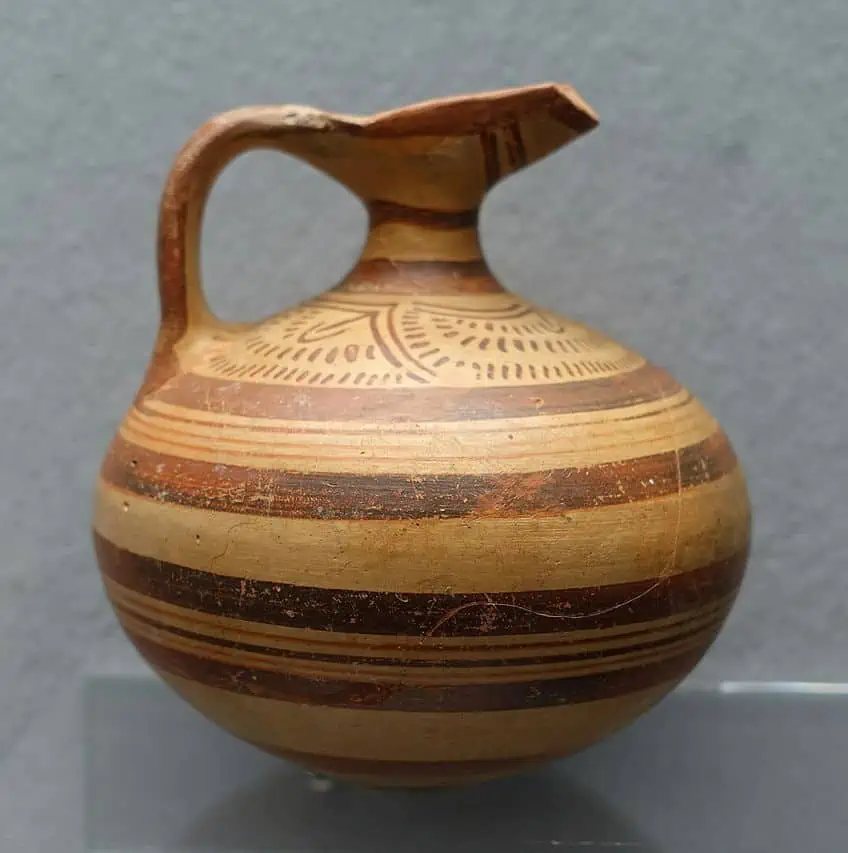
To contextualize the Mycenaeans, one can understand their place in the broader history of time as the civilization that emerged after the Minoan civilization. The Mycenaean society thrived between 1750 and 1050 BCE and was responsible for inventing one of the earliest forms of written Greek known as Linear B syllabic script. An interesting fact about the civilization was that it was run by an elite warrior society composed of a network of complex hierarchical systems across politics and social events. The leader of the Mycenaean society was called a wanax. What makes the Mycenaean society so important to the later Greek civilization of the Classical and Archaic periods is that their history and cultural developments influenced much of the later Greek art, literature, and mythology, as seen in the Trojan Epic Cycle, which became one of the most famous pieces of ancient Greek epic poetry.
The Bronze Age in ancient Mycenae was also understood as the Helladic period, which was derived from the ancient name for Greece, Hellas.
After the last remnants of the Mycenaean society and the fall of the Bronze Age, there was a period in history that evades historians and is known as the Greek Dark Ages, which saw Archaic Greece and the transition from the Mycenaean palace-central hierarchy to decentralized methods of organization. A few reasons as to why the Mycenaean civilization perished have been reduced to speculations around the Dorian invasion, which was a concept derived to explain the replacement of dialects before the Classical Greek era and traditions in Southern Greece that existed before the Classical period. Other theories surrounding their disappearance include natural disasters or climate change. In 1500 BCE, the eruption of Thera occurred, which may have hastened the decline of the Minoan population in Crete and resulted in a positive expansion opportunity for the Mycenaeans who took over Crete by 1450 BCE.
Ancient Mycenaean Art Forms
Art from the ancient Mycenaean period provided scholars with rich information on the culture and its history. From wall paintings to stylized vases, female figurines, jewelry, and large-scale manufacturing sites, the Mycenaean society certainly appreciated the arts. Deities such as Poseidon, Athena, and Zeus also featured in Mycenaean religions with several sacred sites planted in Pylos and Knossos. Below, we will dive into the different art forms of the civilization as well as a few fascinating artifacts!
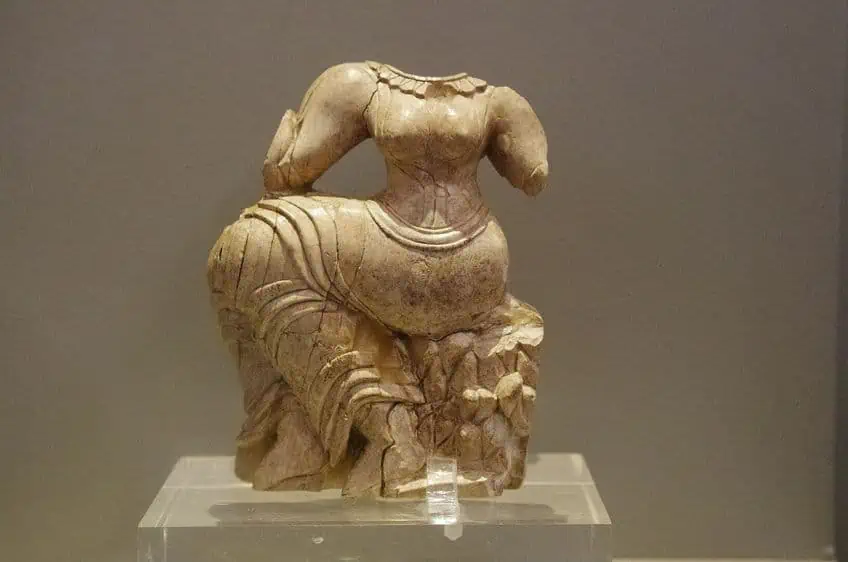
Mycenaean Metalwork
Mycenaean metalwork displays a unique style characteristic of the late Helladic period. Artists from the time used materials such as gold, silver, and bronze to craft ornate artifacts with detailed designs. Some of the techniques used in Mycenaean metalwork included granulation, where small gold spheres would be attached to an object or surface, repoussé, whereby an artist hammered works from the back to create reliefs, and chasing, where artists engraved and incised patterns onto artworks.
These techniques were adopted for jewelry making, weaponry, pottery detailing, and decorative sculptures.
Mycenaean artifacts crafted from precious metals often featured motifs such as animals, plants, marine life, and geometric patterns. Scenes from mythology and warfare are also featured on narrative pieces and included symbols to enhance the meaning. Symbols that featured in Mycenaean artifacts include the linear script B, spirals, bulls with the horns of consecration, warriors, military symbols, sun motifs, and double axes known as labrys.
Mask of Agamemnon (c. 1550 – 1500 BCE)
| Artist Name | Unknown |
| Date | c. 1550 – 1500 BCE |
| Medium | Gold |
| Dimensions (cm) | Unavailable |
| Where It Is Housed | National Archaeological Museum of Athens, Athens, Greece |
Famous metal pieces such as the Mask of Agamemnon are one of the most iconic artifacts of the Mycenaean civilization, which has been dubbed prehistory’s Mona Lisa. The radiant gold mask was discovered in 1876 by archaeologist Heinrich Schliemann, who believed the mask was associated with the Mycenaean king Agamemnon. Modern research proved that the mask predated the legendary Agamemnon, who was the leader of the Achaeans according to the Trojan epic. The mask was discovered at Grave Circle A in a shaft and was part of five bodies that were buried with gold masks.
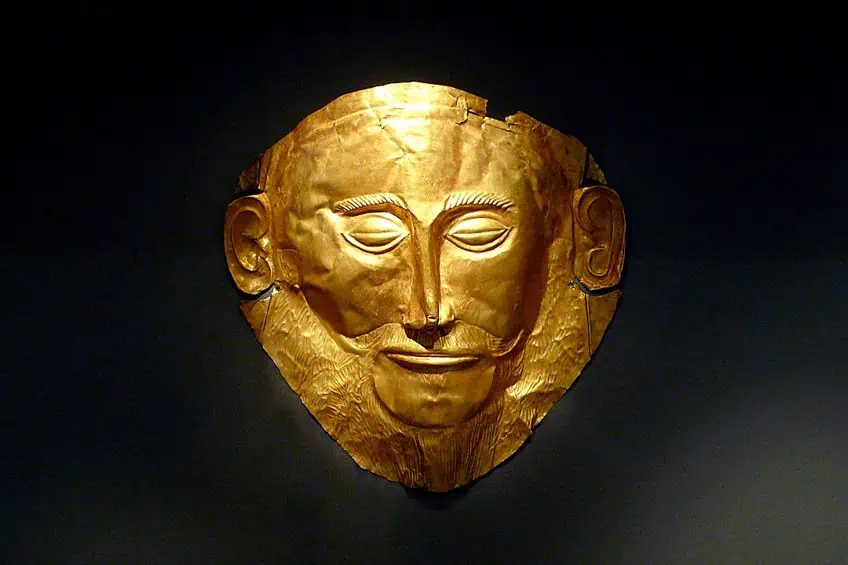
Schliemann believed that the mask was evidence that the Trojan War was real since the gold found in the shaft also indicated the bodies were of men who had the honor and significant social status. The mask itself was crafted from a single sheet of gold, which was heated and beaten with a hammer against a wooden surface. Finer details were later added to the mask using a sharper tool. The funeral mask serves as an iconic symbol of ancient Greece and represents the power of the Mycenaean civilization and its long-standing beliefs in ancient Greek mythology. A few other unique Mycenaean artifacts to explore include a bronze adze (blade) produced between 1600 and 1060 BCE as well as a gold necklace (1200-1000 BCE), produced in Egypt, both of which are currently housed at the British Museum.
Mycenaean Pottery
Art was produced in a variety of ways for trade, decoration, and as symbols of status in pre-Mycenaean societies. The Minoans used luxury artworks to decorate palaces and soon the Mycenaean elites also adopted the tradition and became supporters of the arts. Pottery in the Mycenaean society was influenced by Minoan styles and preferences for the depiction of marine life and creatures such as the octopus and bull-leaping scenes.
Mycenaeans developed their own style, which prioritized a war-like aesthetic, and later reflected influences from the Eastern Mediterranean brought on by economic and political engagements.
Mycenaean Palace Amphora with Octopus (c. 15th Century BCE)
| Artist Name | Unknown |
| Date | c. 15th century BCE |
| Medium | Ceramic |
| Dimensions (cm) | Unavailable |
| Where It Is Housed | National Archaeological Museum of Athens, Athens, Greece |
This three-handle Mycenaean amphora is an example of the Minoan “marine style” handling of pottery, which was executed by a Mycenaean vase painter. The vessel is recognized as a palace vessel that emerged as a tradition in the Late Helladic II and drew heavily from palace amphorae styles found in the Cretan Minoan culture. The amphora is decorated in a sea-themed manner and features images of rocks, seaweed, and three octopi with long tentacles that wrap around the vessel.
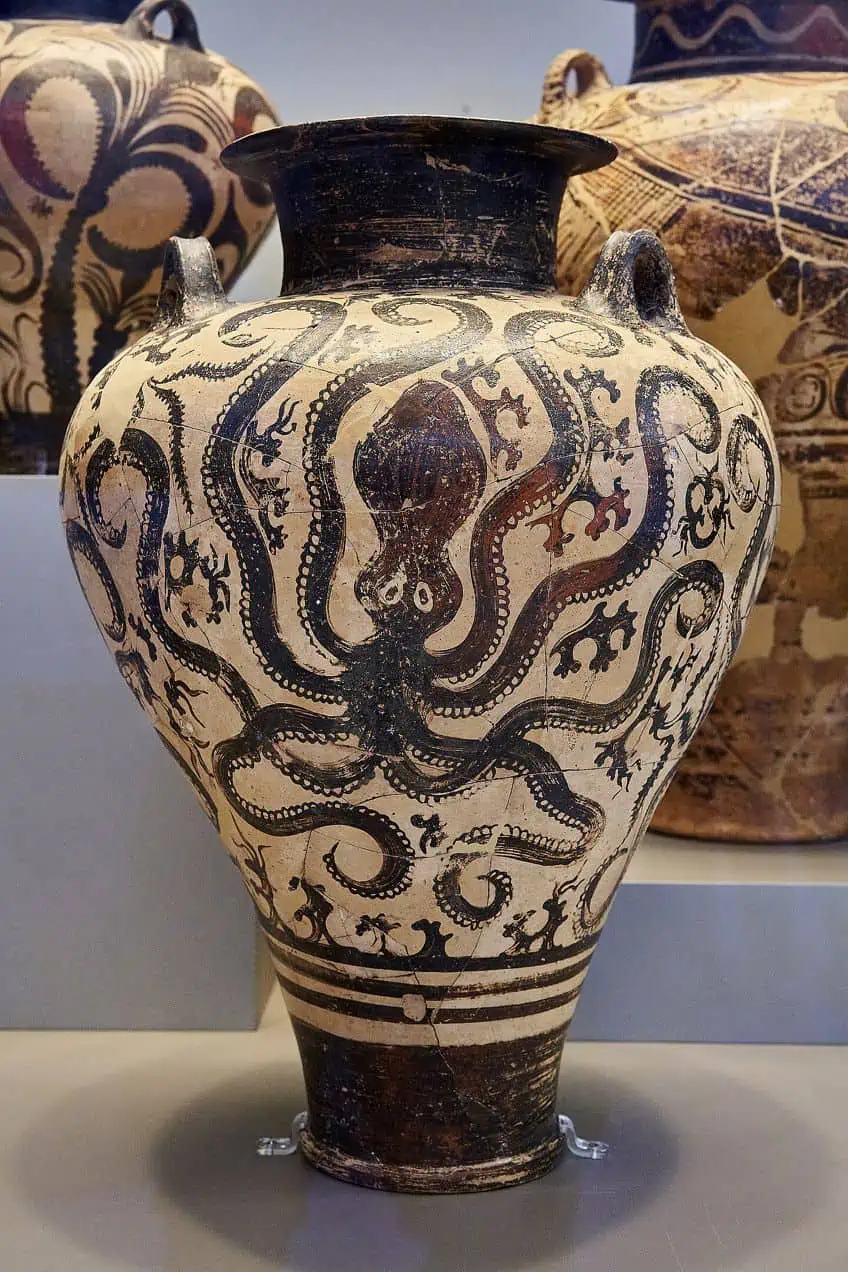
The unique vessel was discovered near Argos in a Mycenaean cemetery and is currently housed at the National Archaeological Museum of Athens. Another significant artifact depicting an octopus is the Terracotta Stirrup Jar with Octopus (c. 1200-1100 BCE) housed at the Metropolitan Museum of Art in New York. The stirrup jar was a vessel created to transport oil and other liquids, and often adopted the marine aesthetic to complement the function of the jar.
Mycenaean Painting
The paintings of the Mycenaean civilization offer a glimpse into their cultural world and were often found in palaces and homes of the elite. Mycenaean frescoes demonstrate unique stylistic qualities and typically portray themes of ceremonial significance, rituals, warfare, and nature. Mycenaean frescoes are characterized by their vibrancy and color palettes of blue, yellow, and red shades with dark outlines and a geometric appearance.
The human figures in Mycenaean paintings are stylized and lack a sense of accurate proportion in anatomy.
Mycenaean artists used hierarchical scaling in their compositions, which saw the depiction of the more important members of society portrayed as larger than the rest. One of the most common features in Mycenaean paintings is the clear influence of the Minoan style, however, some of the unique aspects of Mycenaean paintings are their incorporation of chariots with human figures and battle scenes that are executed with many decorative elements.
Reproduction of the Shield Frieze Fresco (c. 1325 – 1250 BCE)
| Artist Name | Emile Gilliéron |
| Date | c. 1325 – 1250 BCE |
| Medium | Watercolor on paper (reproduction) and fresco (original) |
| Dimensions (cm) | 100.3 x 81.3 |
| Where It Is Housed | National Archaeological Museum of Athens, Athens, Greece (original) and the Metropolitan Museum of Art, New York City, United States (reproduction) |
This reproduced copy of an original Mycenaean fresco was created in the 20th century after its discovery in 1910 in the inner forecourt of Tiryns palace. The restoration of the fresco was led by Emile Gilliéron, who was employed by German archaeologists and was tasked with piecing together the 200 fragments of the fresco to reveal the colorful shield artwork. The fresco contains a figure-of-eight styled motif, which was an iconic motif that served as the link between Homer’s Age of Heroes and the late Helladic era. The green pigment in the original painting was produced using crushed malachite, which was imported from Egypt. Many of the examples of Mycenaean frescoes only survive in fragment form and it is therefore difficult to assess the full nature and development of their painting styles.

Popular subjects in Mycenaean paintings included nature, marine life, and women. Another reproduction of a surviving Mycenaean fresco can be seen in the copy of the Great S-spiral frieze, the original of which is housed at the National Archaeological Museum in Athens. Ornate spiral friezes were incredibly popular in Minoan art and had also influenced the spiral designs found in Mycenaean frescoes along with fan-shaped papyrus lotus blossoms, which featured in palaces. Since similar styles were found in palace settings, it had been suggested that such frescoes were perhaps created by a traveling group of painters who operated on mainland Greece.
Mycenaean Sculpture
Mycenaean sculpture was not short of anything less than creative and offers much insight into the artistic processes of the ancient Mycenaean civilization. Mycenaean sculptures include figurative sculptures, architectural sculptures, and funerary sculptures.
All of these required different techniques and styles.
Three Terracotta Female Figures (c. 1400 – 1300 BCE)
| Artist Name | Unknown |
| Date | c. 1400 – 1300 BCE |
| Medium | Terracotta |
| Dimensions (cm) | 10.8 (h) |
| Where It Is Housed | Metropolitan Museum of Art, New York City, United States |
Figurative Mycenaean sculptures portrayed human and animal figures and were stylized with a geometric form such that the sculptures resembled abstract representations of anatomical features. The famous Mycenaean goddesses are an example of figurative Mycenaean sculptures, which were executed using clay to represent female deities. These figurines were sculpted with a triangular shape and lifted arms, which resembled the earlier Minoan goddess figurines. The terracotta figurines housed at the Metropolitan Museum of Art resemble the shape of the Greek alphabets, which were decorated with wavy lines to resemble drapery. The figurines are identified as the “phi”, “tau”, and “psi” figures, which represent the sculptural style of the Late Helladic IIIA period.

Architectural sculptures were found in palaces, temples, and gateways as decorative elements and relief carvings. These include sculptures at the entrance of the Mycenaean citadel of Mycenae called the Lion Gate Relief (1300-1250 BCE), which represents two lions flanking a central column. Many vase sculptures also included reliefs of warriors engaged in battle. Another common type of Mycenaean sculpture was funerary sculptures, which were found in tombs and were a part of funerary practices. These included grave stelae, grave markers, and tombstones discovered at famous sites such as Grave Circle A, which contained reliefs of hunting scenes, chariots, and warriors. Gold artifacts found in shaft graves were also common at grave sites and included gold jewelry and masks.
Artists used materials such as clay, bronze, ivory, and precious metals to create sculptures with techniques such as engraving, casting, and inlaying.
In terms of style, Mycenaean sculpture can be classified by its fusion of cultural influences and art styles borrowed from the Near East, Egyptian, and Minoan art. What makes the Mycenaean sculpture so “Mycenaean” is that it displays a unique emphasis on symbolism, geometric pattern, and stylized figures. Today, Mycenaean sculptures are considered important artifacts and evidence of the Mycenaean’s funerary practices, religious beliefs, and societal norms.
Mycenaean Architecture
Mycenaean architecture was another opportunity for early architects to employ their creativity and display their passion for warfare and protection. For the Mycenaeans, architecture was one way to showcase the authority and power of the elite and was executed on impressive scales that offer insight into the culture. The Mycenaean civilization was influenced by the Minoan and Cycladic cultures, which impacted the architectural development across funerary sites and the construction of palaces, tombs, and fortifications.
 Lion’s Gate Relief on the Ishtar Gate (575 BCE); Dudva, CC BY-SA 4.0, via Wikimedia Commons
Lion’s Gate Relief on the Ishtar Gate (575 BCE); Dudva, CC BY-SA 4.0, via Wikimedia Commons
The architectural style seen in Mycenaean buildings was characterized by large-scale stone constructions, which featured massive limestone blocks called cyclopean masonry. These large structures were fitted carefully together, impressively, without any mortar, which demonstrated the skill and remarkable stability of the stone. Mycenaean walls were also built in a towering manner to portray a sense of verticality. Among the popular sites to study Mycenaean architecture include the Argolid region’s Citadel of Mycenae, which housed the Lion’s Gate relief and stands as a monumental feature with two lionesses. In the Southwest of Peloponnese is also the Palace of Nestor at Pylos, which showcases the complex hierarchical layout of the palace with storage rooms and large megaron-style halls.
Finally, the Palace of Tiryns situated near Mycenae showcases impressive gateways, a megaron, and cyclopean walls.
Treasury of Atreus (c. 1300 – 1250 BCE)
| Architect Name | Unknown |
| Date | c. 1300 – 1250 BCE |
| Medium | Poros stone, conglomerate, ashlar masonry, and marble |
| Dimensions (cm) | 3,600 x 600 |
| Location | Argolis, Mycenae, Greece |
The treasury of Atreus is considered to be the largest and most elaborately designed tholos tomb of the Aegean Bronze Age, which was named after the mythical figure Atreus and was intended to house the body of a ruler. The tomb was discovered in the 19th century by Thomas Bruce, the Ottoman governor, Veli Pasha, and later excavated by Heinrich Schliemann and Panagiotis Stamatakis. In the 20th century, the British School at Athens conducted further excavations at the site to determine the date of the tomb’s construction. Considering the time at which the Mycenaean architects worked on these palaces and structures, one can admire their highly sophisticated techniques that made use of Cyclopean masonry or irregular-shaped stones, which required precise planning. Devices like post-and-lintel constructions as well as columns and large stones for support were also common.
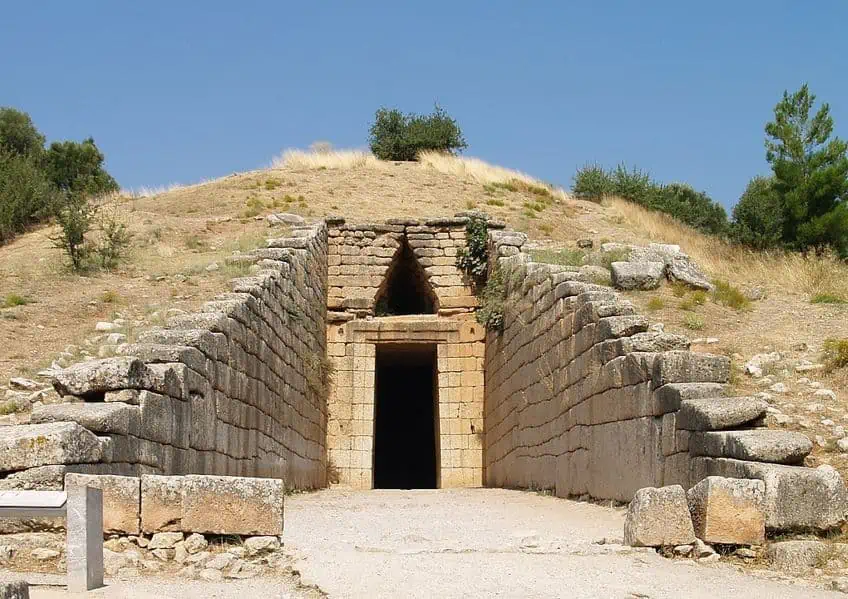
A few interesting facts about Mycenaean architecture include the prevalence of features called megarons, which were central to palace architecture and were constructed with a rectangular hall that contained a central hearth and a megalith or throne room on one end. Mycenaean architecture is also famous for its tholos tombs, which are characterized by circular burial chambers encased in a corbelled vault.
The Tomb of Agamemnon is a well-known example of a tholos tomb.
Corbelled arches were used to create Mycenaean entranceways and support structures. The technique used for creating these arches involved the layering of stones, with each stone projecting slightly outward from the one below it until they converged at the top. Fortification in Mycenaean architecture was common since the civilization was somewhat passionate about warfare and therefore built massive walls with cyclopean masonry as defensive devices that also conveyed a sense of grandeur.
The many art forms of the Mycenaean civilization hold a significant place in the history of ancient Greece. Mycenaean art showcases the cultural achievements and beliefs of the Mycenaean civilization through distinct styles and techniques, which subsequently influenced Greek artistic traditions. The symbolism and grandeur of Mycenaean art seen in their architecture, paintings, and relief sculptures contributed to the foundational elements for later periods that shaped many Western cultures.
Frequently Asked Questions
What Is Mycenaean Art?
Art from the culture of the Mycenaean civilization that occupied Greece between 1600 and 1100 BCE is recognized as Mycenaean art. This type of ancient Greek art is commonly found in Mycenae in the Peloponnesus, and is best known for its vibrant frescoes, war scenes, militaristic references, mythology, and nature scenes.
What Is the Difference Between Mycenaean Art and Minoan Art?
Minoan art and Mycenaean art are different in stylistic characteristics. Mycenaean art was simplistic and bold, as seen in their vibrant use of color and preference for geometric forms, while Minoan art contained female imagery, elaborate décor, and specific iconographies. Minoan art relied on religious iconography and references to a social matriarchal structure, while Mycenaean art focused on war, power, and territorial expansion.
What Art Forms Did the Mycenaeans Practice?
The Mycenaean civilization practiced many art forms, including fresco painting, pottery, metalwork, weaponry design, death masks, sculptures, architecture, and jewelry.
Liam Davis is an experienced art historian with demonstrated experience in the industry. After graduating from the Academy of Art History with a bachelor’s degree, Liam worked for many years as a copywriter for various art magazines and online art galleries. He also worked as an art curator for an art gallery in Illinois before working now as editor-in-chief for artfilemagazine.com. Liam’s passion is, aside from sculptures from the Roman and Greek periods, cave paintings, and neolithic art.
Learn more about Liam Davis and about us.
Cite this Article
Liam, Davis, “Mycenaean Art – An In-Depth Guide to Ancient Greek Art.” artfilemagazine – Your Online Art Source. August 2, 2023. URL: https://artfilemagazine.com/mycenaean-art/
Davis, L. (2023, 2 August). Mycenaean Art – An In-Depth Guide to Ancient Greek Art. artfilemagazine – Your Online Art Source. https://artfilemagazine.com/mycenaean-art/
Davis, Liam. “Mycenaean Art – An In-Depth Guide to Ancient Greek Art.” artfilemagazine – Your Online Art Source, August 2, 2023. https://artfilemagazine.com/mycenaean-art/.


